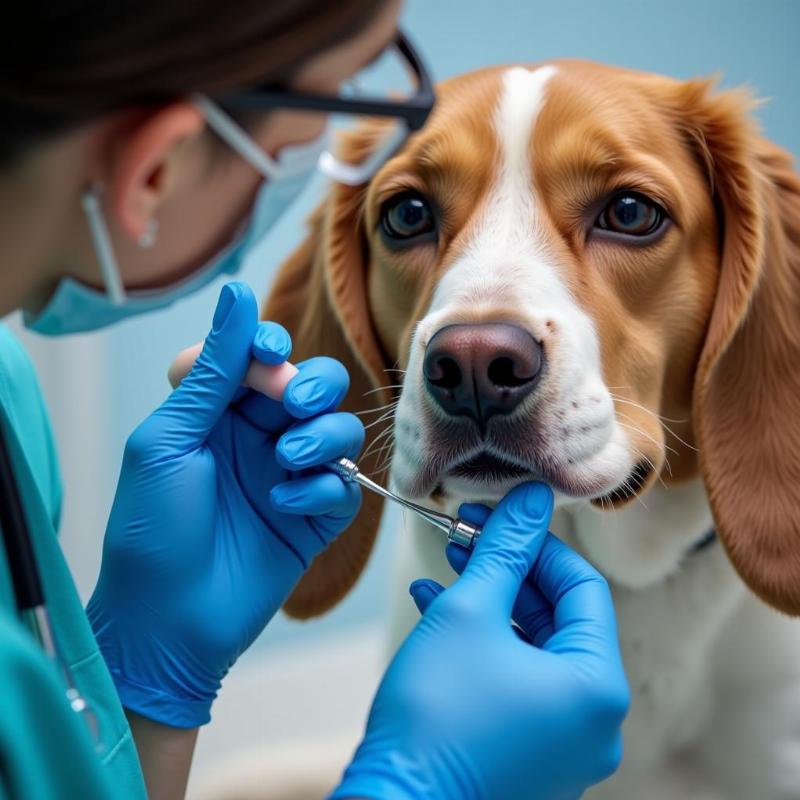Breeding dogs is a significant decision, and understanding the age limitations for both male and female dogs is crucial for responsible pet ownership. Knowing when a dog is too old to breed ensures the health and well-being of the dog and contributes to producing healthy puppies. So, when are dogs too old to breed? Let’s delve into the factors influencing breeding age and discuss the considerations for responsible breeding practices in the United States.
Breeding Age in Female Dogs
For female dogs, or bitches, breeding age is a complex issue. While they can technically become pregnant and bear puppies throughout much of their lives, the risks significantly increase as they get older. Generally, veterinarians recommend against breeding a female dog after the age of seven or eight. This is due to a higher chance of complications during pregnancy and delivery, such as dystocia (difficult birth), pre-eclampsia, and uterine infections. Older females may also have a lower fertility rate and produce smaller litters.
Furthermore, pre-existing health conditions can be exacerbated by pregnancy in older dogs, posing a threat to both the mother and the puppies. For example, heart disease, kidney problems, and arthritis can become significantly worse during pregnancy. Responsible breeders prioritize the health of their dogs and avoid breeding females who may be at risk.
Breeding Age in Male Dogs
While male dogs, or studs, don’t experience the same physical limitations as females regarding pregnancy and delivery, their fertility can decline with age. While they can technically continue to sire puppies into their senior years, sperm quality and quantity tend to decrease after the age of eight. This can lead to smaller litter sizes and a higher risk of birth defects.
 Tuổi sinh sản của chó đực
Tuổi sinh sản của chó đực
Additionally, older male dogs may experience health issues that can impact their ability to breed successfully. Conditions like prostate enlargement, testicular cancer, and hormonal imbalances can affect fertility and overall well-being. Responsible breeders will typically retire their male dogs from breeding when they reach a certain age or show signs of declining health.
American Kennel Club (AKC) Recommendations
The American Kennel Club (AKC), the premier purebred dog registry in the United States, provides guidelines for responsible breeding practices. Although the AKC doesn’t set strict age limits for breeding, they emphasize the importance of prioritizing the health and well-being of the dogs. They encourage breeders to consult with veterinarians to assess the suitability of their dogs for breeding based on factors like age, overall health, and breed-specific considerations.
What Happens if a Dog Breeds Too Late in Life?
Breeding a dog too late in life, especially a female, can have several negative consequences. These can include increased risk of stillbirths, birth defects, smaller litter sizes, and health complications for the mother, such as difficult labor and uterine infections. These risks underscore the importance of making informed breeding decisions based on the dog’s age and overall health.
Frequently Asked Questions (FAQ)
- At what age is it best to breed a dog? Generally, the optimal breeding age for female dogs is between two and six years old.
- Can a 10-year-old dog get pregnant? While possible, it’s not recommended due to the increased health risks for the mother and puppies.
- Do male dogs have a breeding age limit? While male dogs can technically breed into their senior years, fertility decreases after the age of eight.
- What are the signs of declining fertility in male dogs? Smaller litter sizes, difficulty impregnating females, and changes in semen quality.
- What are the AKC breeding recommendations? The AKC emphasizes responsible breeding practices and encourages breeders to consult with veterinarians.
- Is it safe to breed a dog with pre-existing health conditions? Generally, it’s not recommended, as pregnancy can exacerbate these conditions.
- What are the risks of breeding a dog too late in life? Increased risk of stillbirths, birth defects, smaller litter sizes, and health complications for the mother.
Conclusion
The decision of when to breed a dog should be made carefully and responsibly, taking into consideration the dog’s age, overall health, and breed-specific factors. Breeding dogs too late in life can pose significant risks to both the mother and the puppies. Consulting with a veterinarian is essential for making informed breeding decisions and ensuring the health and well-being of all dogs involved.
Related Articles
Beautdogs.us is your premier online destination for comprehensive dog care information and resources. We offer expert guidance on dog breeds, grooming, nutrition, training, and health. Whether you’re a new dog owner or a seasoned enthusiast, Beautdogs.us is your trusted source for all things dog-related. Contact us today for personalized support! Email: [email protected], Phone: +1 501-555-7529. Connect with us at Beautdogs.us for all your dog care needs!